Why Your Shampoo Might Be Doing More Harm Than Good

Whether your hair care routine is short and simple or slightly more elaborate, there’s one product that everybody uses; shampoo. Shampooing your hair is one of the most basic of hair care steps. It needs to be done regularly in order to keep your mane feeling clean and healthy.
However, what many people don’t realize is that not all shampoos share the same altruistic goal. Many of the shampoos out there are formulated with ingredients that could actually be doing more harm than good for your hair. How can you tell? Read on as Evalectric explains.
Why is Shampoo So Important in the First Place?
While everyone knows that shampoos are designed to remove dirt, oil, and other debris from our strands, there is more to these hair care products than just this. In addition to cleaning your hair, shampoos also work to remove buildup from the scalp. Since your scalp is where your hair grows from, keeping scalp health in check will go a long way in giving you locks that feel stronger, smoother, and healthier.
Some shampoos are also tailored to address certain hair issues. Whether you’re dealing with dandruff, dryness, color-treated hair, or anything else, a dedicated shampoo will help to meet the unique needs of your mane.
Some shampoos offer moisturizing properties too. Sure, this may be the role of your conditioner, but there’s no such thing as giving your hair access to too much moisture! The better moisturized your strands are, the silkier and glossier they’ll look.
The Problem With Some Shampoos
So, what’s the issue? The fact that some shampoos contain overly harsh cleansing agents and harmful chemicals. Yes, they’ll still clean your hair and scalp, but they’ll do this a little too well, interfering with the scalp’s microbiome in a way that causes dryness, irritation, hair loss, and a whole host of other problems.
You may not notice the effects of this straight away but, after a few washes, a low-quality shampoo will really start to take a toll on your strands. The more you use that shampoo, the more harm you’ll cause to your hair until you reach a point that’s difficult to come back from.
Of course, even a high-quality shampoo can cause issues if you’re using a formula that isn’t suitable for your hair type. This is why it’s so important to spend some time exploring your options so that you pick a shampoo that’s not only compatible with your hair’s needs but is also not going to damage your hair or scalp.
Choosing the Right Shampoo for Your Hair

First things first, understand your hair type. This will help to narrow down your many shampoo options:
- Dry, thick, or damaged hair – when hair is desperate for moisture, a rich hydrating shampoo, like the argan oil-infused Moisturizing Shampoo from Evalectric, is a must.
- Oily hair – an oil-free shampoo would be your best bet, coupled with a clarifying shampoo that’s used once a week or so.
- Fine hair – a lightweight shampoo is important to prevent weighing your strands down.
- Color-treated hair – a color-safe shampoo is essential if you want to keep your hair color looking vibrant rather than faded.
- Curly/coily hair – some shampoos are designed to enhance curl definition while minimizing the look of frizz.
Next, make sure that the shampoo you choose doesn’t contain any harmful ingredients. Be wary of formulas containing parabens, silicones, and harsh chemicals. This part will require a little research as you’ll likely need to study the ingredient list of each shampoo you’re considering before looking up what each of those ingredients are/do.
Determining How Often to Shampoo Your Hair
Even if you pick the perfect shampoo for your hair type, going for a formula that only contains gentle, hair-loving ingredients, you could still end up doing more harm than good with your shampooing efforts. How? By using your shampoo too often.
Overwashing is becoming quite a common problem. Many people are under the impression that the more they wash their hair, the healthier it will be. In reality, however, this isn’t true. While you definitely don’t want your strands and scalp to be weighed down by oil and other impurities, a small amount of oil is essential for keeping your strands moisturized and lubricated. Wash your hair too often and you’ll be removing that protective layer of oil faster than your scalp is able to produce more. This can quickly lead to dry and brittle strands.
So, how often should you be shampooing your hair? Unfortunately, there isn’t a definitive answer to this. It all depends on your hair type, as well as the type of shampoo you’re using. Those with dry or damaged hair need to be particularly careful as over-shampooing will quickly exacerbate your issues. With that said, over-shampooing oily hair is detrimental too. This will only increase scalp sebum production in the long run, leaving your hair looking greasier than ever.
As a general rule of thumb, those with oily hair will probably need to use a shampoo every couple of days. If your hair is extremely thick or coily, you’ll sit on the other end of the shampoo spectrum and should only wash your hair every week or two. If your hair is somewhere in the middle, then your shampooing frequency should be too.
Applying Your Shampoo Correctly
Another way in which a shampoo can harm your hair is if it’s applied incorrectly. While you may think that shampooing is a very straightforward process, there are a few ‘rules’ that need to be followed if you want to see maximum benefits from your efforts.
The first is to start with hair that’s fully wet. This may seem obvious but when you’re in a rush, it can be easy to make a mistake here. If you want your shampoo to work properly, make sure that you soak your strands for a couple of minutes before you apply your shampoo. Sectioning your hair can help to speed this up by making it easier for water to reach every strand, as well as your scalp.
Once it’s time to apply your shampoo, don’t use too much product. Short hair only needs a nickel-sized amount while long hair benefits from a half-dollar-sized dollop. Then, start at your scalp, using your fingertips to massage your shampoo in to create a lather. Aim to spend about three minutes working your shampoo into your scalp. Then, gradually draw your shampoo down to your mid-lengths, but avoid directly shampooing the tips of your hair. This is the driest part of your hair – sebum often struggles to reach the ends. The run-off from when you rinse off your shampoo will be more than enough to cleanse this area.
Speaking of rinsing, this is something else that could end up harming your hair if you don’t do it properly. Again, it can be helpful to section your hair at this stage to ensure that you remove every trace of shampoo. Failing to do so will lead to buildup, which will affect the overall health of your scalp and hair.
Following Up With a Conditioner

Even the gentlest of shampoos will still leave your hair feeling a little vulnerable and parched once you’re done. After all, you’ll be removing the sebum that keeps your hair moisturized.
This is why it’s crucial to always follow a shampoo up with a conditioner. This will restore some of the moisture that you’ve lost while giving your hair a much smoother and silkier finish.
Try to pick a conditioner that complements the shampoo you’ve chosen. For example, if you’ve decided to use the Evalectric Moisturizing Shampoo, the Evalectric Moisturizing Conditioner, which can be found in our Deluxe Set, would be a great partner.
What About Clarifying Shampoos?
Clarifying shampoos can be another problem area. These shampoos are known for providing an even deeper cleanse than a regular shampoo. They’re great for removing deep-seated debris and product buildup, along with chlorine, minerals from hard water, and more.
While clarifying shampoos may be in the spotlight at the moment, it’s important to recognize that not everybody needs to use one. If you have a dry or sensitive scalp, a clarifying shampoo will likely only cause irritation. Likewise, if your hair is color-treated, a clarifying shampoo, unless it’s specifically designed for colored hair, will cause your color to fade much faster.
If your hair would benefit from a deeper cleanse every once in a while, go ahead and add a clarifying shampoo to your hair care routine. However, just like with a regular shampoo, it’s important not to use it too often. Try to save your clarifying shampoo for every three to five washes. The exception would be if you regularly swim – you may need to clarify more frequently to prevent chlorine from building up.
What About Dry Shampoos?
The name ‘dry shampoo’ is a little misleading. Why? Because these products don’t actually clean your hair, meaning that they aren’t true shampoos. Instead, the purpose of a dry shampoo is to absorb any excess oil that happens to be lingering on your locks. The ingredients within a dry shampoo will soak up that grease to instantly give your hair a fresher finish. They’re great for a last-minute touch-up, as well as for extending the lifespan of a blowout, but they don’t actually remove any oil, meaning that they should never be considered a replacement for a regular shampoo.
The good news is that so long as you regularly shampoo your hair, there aren’t any dangers to be wary of when it comes to using dry shampoos. So long as you periodically remove your dry shampoo with a wet shampoo, the two products can complement each other pretty well!
Summary
As essential as shampooing your hair may be, you need to ensure that you aren’t making any mistakes that could end up harming your locks. Be it using a poor-quality shampoo, shampooing your hair too often, or applying your shampoo incorrectly, spend some time honing your shampooing habits so that you can be confident that your efforts are benefiting your hair as much as possible.
Click here to shop for more bestselling hair products from Evalectric.






